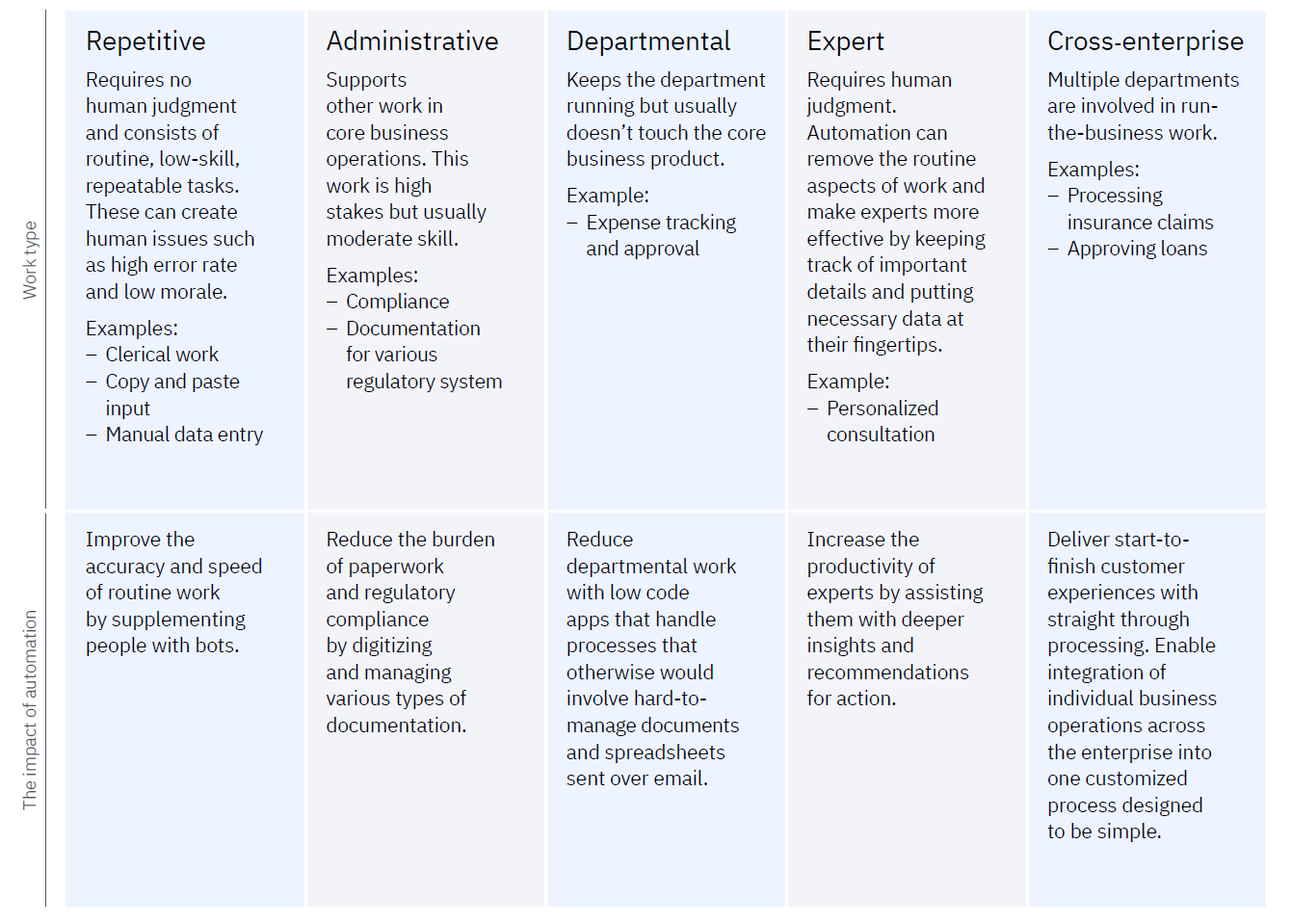Automating work: What does automation success look like?
Authored by Tony Doyle based on an original piece by Brian Safron and Cheryl Wilson from IBM.
This blog is part of a series. Click here to read Part 1 of the Automating work blog ‘What it means and why it matters’. At any time, you can reach out to Insight 2 Value to organise a Business Automation Readiness Workshop to help you accelerate your journey and plan your next steps.
Where can you usefully apply automation?
Every business has tasks that range from the simple and repetitive to the complex and unique. And you can usefully apply automation in virtually all types of work.
Five types of work common to most organisations and the impact of automation

Automation Success
Successful automation isn’t singular—it doesn’t come from one project or solution. It’s an iterative process that adapts to your changing business needs.
Successfully automated companies often share the following markers:
- They focus on the needs of their customers.
- They recognise the importance of scalability while still being able to offer each customer a personalised experience.
- They keep the automation system as flexible as they can by building on an extensible platform and keeping good alignment between business and IT.
- They’ve taken everything that can be made efficient and made it efficient.
To get to successful automation, recognise that it’s a process, and it doesn’t happen with a big bang. Also, you’ll probably need some of the following capabilities, depending on the type of work you want to automate to drive growth:
- Automating tasks with robotics
- Sharing, managing, controlling and collaborating on critical business content
- Designing and managing start-to-finish workflows
- Automating decisions with business rules
- Capturing and extracting data from documents
What’s likely to stand in your way?
Automation isn’t a quick and easy process. The following choices can create pitfalls:
- Forgetting to engage business and IT people together, early enough.
When you’re doing automation, not committing fully to business and IT alignment can hurt your efforts. Business needs to get IT in the room from the beginning as a reality check – to help ensure costs, timelines and project scope are realistic. IT can help to prevent purchase mistakes. For example, an IT expert in a meeting with a technology vendor can flag promises that are too good to be true. The flip side is to be aware of IT fiefdoms. Focus on solving the business problem and the service you require and ask IT to support those decisions and not put up obstacles. - Trying to do it all at once.
Trying to address all of your automation goals with one big launch can lead to trouble. By going incrementally and making continuous improvements, you give yourself room to experiment and then fix what didn’t work. Ask your partner to demonstrate that they can be agile and focus on quick wins. One way to do that is to discuss fixing the costs of your engagements to control scope creep and delay. - Thinking packaged apps are going to solve all of your problems.
Packaged apps that promise to deliver automation in one box might fit some of your needs. The challenge arises when you try to use them for problems they aren’t good at solving. - Failing to embrace the flexibility of Cloud Managed Solutions.
Modern Automation solutions are all about deploying new solutions quickly and at scale. Overburdened in house IT departments having to worry about on-premise systems management simply don’t have the capacity to support your need to accelerate change.
In our next blog in the series, we’ll look at where to start!
Is your Business Ready for Business Automation?
A Business Automation planning workshop.
Insight 2 Value is offering a no-obligation free-of-charge business automation planning workshop. We’ll sit down with you to understand your current cost models and work through the potential to eliminate your sunk ECM costs and build a Return on Investment model to accelerate your move to a consumption-based cloud platform. We’ll also help you navigate the technical steps you’ll need to take to minimise business disruption and explain the different options available to you in adding Business Automation into your overall Cloud Strategy.



